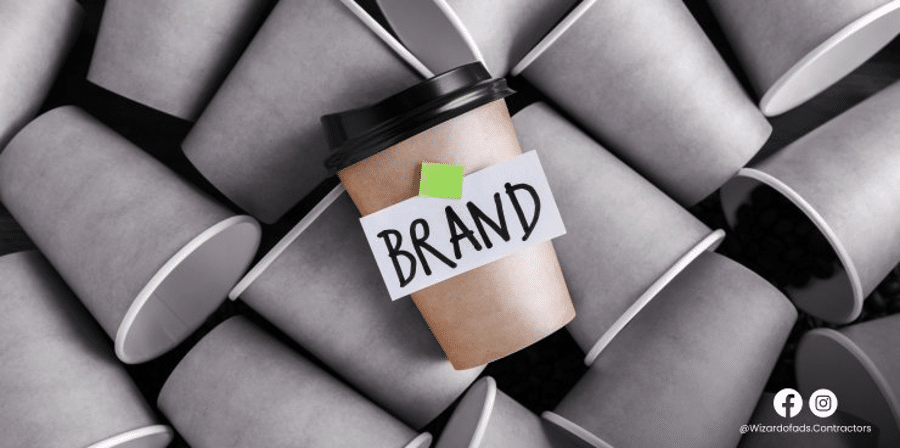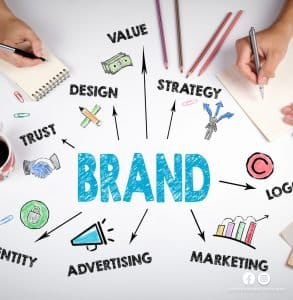
One of the primary goals of businesses is to be memorable. You want to transcend being ‘just another service provider’ and be recognized as your category’s go-to provider. Creating a memorable brand helps in achieving this goal. Companies use many tactics to attain this level of recognition.
Two of the most standard strategies are using taglines (or slogans) and positioning statements. While they may sound similar, there are distinct differences between the two. How many taglines of products do you recall? Having a catchy tagline or slogan helps customers remember your brand in a sea of sameness.
Positioning statements, on the other hand, focus on how your brand is unique and differentiates itself from the competition. Positioning statements help your team align their marketing and advertising efforts to your brand identity. But there’s another tool that can help businesses establish powerful branding and stand 600 ft. above the competition: brandable chunks.
You may have yet to hear of brandable chunks, which poses a huge opportunity. Why? If you want to lift your business up to be a household name, using brandable chunks is your ticket to greatness.
In this article, we’ll take a deep dive into taglines (slogans), positioning statements, and brandable chunks. We’ll uncover the differences among the three and explain why brandable chunks should be at the core of your marketing. Keep reading.

Fewer but Better Leads
Roy H. Williams was once asked by a marketer how to get fewer but better leads. After all, it’s better to capture 10 percent of the audience 100 percent of the way, than 100 percent of the audience only 10 percent of the way.
Like what every other marketer would suggest, Roy recommended targeting. However, he emphasized using broad targeting, not narrow. Here are the best 2 ways to perform broad targeting:
- Geographical. Target audiences based on your trade area.
- Psychographic. Target audiences based on “buyer personas” as suggested by their purchase history or affinity groups.
You may ask, isn’t it counterintuitive to broadly target if you want fewer but better leads? The short answer is an enthusiastic “No”! Let me explain.
The principal motivation behind every buying is to want— you want something, so you buy it. This is what you observe in the retail industry. That’s why you can target customers based on niche interests and online behavior. However, you’re selling an externally triggered grudge purchase in many companies, for example residential home services. That means people don’t buy your solutions out of WANT (on a whim) but out of NEED. The only thing they really want in this situation is for the pain to go away.
People don’t wake up thinking, “Today feels like a good day to have my toilet fixed.” In other words, only when a problem arises. These problems can occur randomly at any given moment; therefore, broad targeting is more logical in this industry. Having better leads means that people are coming to you for the RIGHT reasons.
You want leads who believe you will deliver the service better than anyone else. Otherwise, low-quality leads will come to you, which means lower conversion chances.

Taglines/Slogans vs. Brandable Chunk vs. Positioning Statement
Let’s discuss these three, how they’re relevant in your ad copy and differentiate them from one another.
Taglines (Slogans)
Taglines, also known as slogans, are catchy phrases used in advertising campaigns to attract customers. There need to be more formulas used to create taglines for businesses. Some keep it short, while other companies like theirs a bit longer. You can use the taglines to feature the main benefits or purpose of the brand or communicate your value proposition. A few tagline examples include:
- Nike’s “Just Do It”
- McDonald’s “I’m Loving It”
- KFC’s “Finger-lickin’ good”
Taglines and slogans can be powerful tools provided they’re catchy, memorable, and induce a strong brand recall. However, the prerequisite of having such a privilege is establishing your business as a household name. Well, that’s easier said than done.
Positioning Statement – What is your SKIMP?
Positioning statements are your brand’s way of differentiating itself on the Sea of Sameness. They often describe your unique value proposition. In it, you also declare how your brand wants to be perceived by its target market.
Unlike taglines and slogans, positioning statements are often internal guidelines for all the departments under your umbrella. While you can plaster your positioning statement on your website, it’s more commonly an internal document. This enables your team to make advertising, marketing, and strategic decisions aligned with your positioning statement. Positioning statements answer the question:
- What is the SINGLE KEY INFLUENTIAL MESSAGE to PERSUADE (SKIMP) that we won’t skimp on?
The only problem is that positioning statements look at the big picture, which means it’s too broad to clearly define every part of your business. You should not publish your positioning statement in your advertising and pray it converts. Simplifying positioning statements into smaller bits is the key; that’s where brandable chunks come in.
Brandable Chunks
Brandable chunks are micro-positioning statements that explain an aspect of your business. Unlike all-encompassing positioning statements, brandable chunks are small memorable lines that people distinctively associate with your company.
In other words, when people hear your brandable chunks, customers know they’re from your business. What’s good is you can easily have a dozen brandable chunks that are meaningful and memorable. Why exactly do brandable chunks work?
“Brandable chunks are memorable, micro-differentiators.”
Unless done by a household brand with a strong following, taglines and slogans remain white noise — Adspeak. They are lines you wish people would willingly believe in, but they usually don’t. That’s where brandable chunks are so much different and much more refined.
“Brandable chunks are refined from average advertising in the same way that hi-octane gas is refined from crude oil.”
— Roy H. Williams
Here are five reasons why brandable chunks work better than taglines:**
1) Create vivid mental images .**Brandable chunks give off imagery that taglines simply can’t. They paint a picture in the mind’s eye and help potential customers remember your brand.
For example, when I say, “Stand 600 ft. above your competition,” what do you think of it? Do you see your business elevated and all your competitors clawing their way up to share the top with you? How about when I say, “Sea of Sameness“? Do you imagine a sea of brands that get lost in obscurity because they’re all similar?**
2) Employ unusual word combinations .**Brandable chunks also use unique combinations of words, making them more memorable and catchy. Take “Sales is a dance and closing is jujitsu,” for example. It’s much more effective and attention-grabbing than saying sales is a long process and closing is sealing the deal. You create better imagery when unusual words are combined in perfect harmony.
3) Communicate features and benefits succinctly Brandable chunks often communicate the features, benefits, and advantages of a brand in a catchy manner. Look at Wizard of Sales® CORE Purpose: “to protect and defend a happy, healthy, wealthy culture.” The line describes the Leader’s purpose of integrating the CORE Principles into your business culture.**
4) Have meter (rhythm) so they tumble off the tongue . **Brandable chunks must be accessible on the tongue and smooth to the ears. That’s how you make them memorable.
5) Have a pattern interrupt that doesn’t quite fit, but makes sense. One of our clients is “The Pros Who Knows”. While not grammatically correct, it fits. This breaks past Brocha, the gatekeeper of the mind, and shows up in your customer’s imagination, ready to party all night long.
 Brandable Chunks in Radio Ads
Brandable Chunks in Radio Ads
The best thing about brandable chunks is they’re usable in every marketing effort. You can throw brandable chunks in your ad copy, home page, or social media post without remorse. People will not get sick of listening because it’s not sales-y; brandable chunks are a means to remember your business. That’s why brandable chunks work wonders in radio ads, TV ads, and billboards. Since it rolls off the tongue easily, it can be quickly delivered through speech or copy.
Moreover, unlike taglines, you can sprinkle various brandable chunks across a single ad. In Roy H. Williams’ memo, he demonstrated how he simplified two radio ads and infused brandable chunks throughout.
Brandable Chunks are Never Predictable
Taglines are predictable. You usually say them at the end of an ad. Positioning statements are predictable. They remain the same throughout the lifespan of the company. Brandable chunks, however, are unpredictable. Why? Because there are so many things to choose from. You could use over 20 brandable pieces throughout your business touchpoints.
What makes them more predictable is that there’s no limit to their usage. For instance, here are ways you can use them:
- As headlines
- Scattered across your web pages
- A way to answer the phone
- Opening and closing statements
- Conversational tidbits
Can you imagine saying your tagline repeatedly when talking to your audience? Yuck. Having taglines and positioning statements is excellent for marketing. However, creating your own set of brandable chunks is a better way to attract the right people with your ad copy. Plus, they are great tools to help customers recall your brand whenever they hear them.
Need brandable chunks? Wizard of Ads™ can help you. Book a call.
- Futuristic Game for the Ad Masters - July 11, 2024
- Classical Conditioning: Pavlov’s Dog in Advertising - June 20, 2024
- Hear, See, Speak No Advertising - June 9, 2024

 Brandable Chunks in Radio Ads
Brandable Chunks in Radio Ads